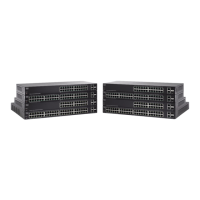Spanning Tree Protocol
Configuring Multiple Spanning Tree
Cisco 220 Series Smart Switches Administration Guide Release 1.1.0.x 158
12
- Backup—The port provides a backup path to the designated port path
toward the Spanning Tree leaves. Backup ports occur when two ports
are connected in a loop by a point-to-point link. Backup ports also occur
when a LAN has two or more connections connected to a shared
segment.
- Disabled—The port does not participate in the Spanning Tree.
• Mode—Displays the current Spanning Tree mode.
- STP—Classic STP is enabled on the port.
- Rapid STP—RSTP is enabled on the port.
- MSTP—MSTP is enabled on the port.
• Type—Displays the MSTP type of the port.
- Boundary—A Boundary port attaches MSTP bridges to a LAN in an
outlying region. If the port is a boundary port, it also indicates whether the
device on the other side of the link is working in RSTP or STP mode.
- Internal—The port is an internal port.
• Designated Bridge ID—Displays the bridge ID number that connects the
link or shared LAN to the root.
• Designated Port ID—Displays the priority and port ID on the designated
bridge that connects the link or the shared LAN to the root.
• Designated Cost—Displays the cost of the port participating in the STP
topology. Ports with a lower cost are less likely to be blocked if STP detects
loops.
• Remaining Hops—Displays the hops remaining to the next destination.
STEP 5 Click Apply. The Running Configuration is updated.

